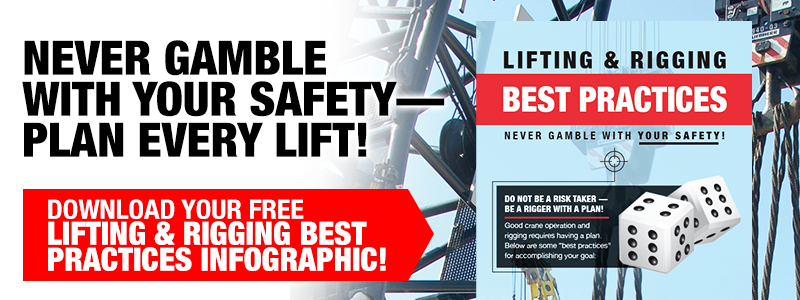Proper training is crucial when it comes to rigging and lifting loads safely. Implementing and understanding proper terminology is vital to safety, ensuring you communicate clearly and are understood. Understanding the “why” behind the terminology and design of your lifting products can ensure you are operating safely. In this rigging toolbox talk, we’re answering some common questions that reveal gaps to be addressed in maintaining best practices. Even experienced rigging crews should take the time to brush up on key concepts periodically. Keeping your knowledge sharp is the key to staying safe and ensuring that everyone goes home in one piece at the end of the day.
In this rigging toolbox talk, we answer common questions like:
- What’s the difference between SWL and WLL?
- How are safety factors vs. design factors different?
- What goes into calculating working load limits for cranes vs slings?
- Who is a dedicated spotter for crane lifts?
- Does double wrapping a sling affect its working load limit?
Whether you’re a rigger, lift director, or crane operator, it’s important to understand these key rigging concepts. We break down the specifics in easy-to-understand terms. This video provides a perfect opportunity to improve your working knowledge of:
- Rigging Vocabulary – from outdated SWL terminology to current WLL standards
- The role safety and design factors play in product design
- Sling vs Crane WLL/Rated Capacity
- Responsibilities of a dedicated spotter and signal person
- The effect of double wrapping a sling on capacity
So join us for another informative rigging toolbox talk where we decode need-to-know concepts that keep lifting jobs safe and efficient.
Transcript
Welcome To Another Rigging Toolbox Talk
Today, I’m taking up five questions we’ve been asked about rigging and lifting a load. It’s another Toolbox Talk. My name is Ben and this is the Lifting & Rigging Channel. Today, I’m answering your questions about rigging a load. You’re the lift director here. If you have a question that you want answered, drop it in the comments below.
What is the difference between SWL and WLL?
First question, what is the difference between SWL and WLL? SWL stands for safe working load. WLL stands for working load limit. People sometimes use these interchangeably, so what’s the difference? Basically, SWL, or safe working load, is an old term, so if you’re a gray beard rigger or if you learned from one, you may be using SWL out of habit. In the United States, we stopped using the term safe working load about 20 years ago. Europe and ISO standards also stopped using the term a few years later. The term was replaced with working load limit for basically everything below the hook, and rated capacity for cranes, hoists, and winches.
Why? There are legal implications to implying something is safe, so SWL should no longer be used, and working load limit should be used when referring to a piece of rigging’s maximum working load.
What is the difference between safety factor and design factor?
Similar question. What is the difference between safety factor and design factor? I reached out to our partner ITI, Industrial Training International, to get some help with this answer. In the past, safety factor was used more often, but is now a bit of an antiquated term, but there is a difference between the definitions, and safety factor is still used depending on what you are discussing.
In rigging, we tend to avoid this term and use design factor instead. The difference between safety factor and design factor is as follows: the safety factor is how much the design part actually will be able to withstand. The design factor is what the item is required to be able to withstand. The safety factor is more specific and often used to evaluate the safety of a particular component or structure in relation to its intended load, while the design factor is a broader concept used in the overall design process to account for uncertainties and variations. Both factors play a crucial role in ensuring that structures are safe, reliable, and capable of withstanding expected loads while allowing for uncertainties and variations in real world conditions.
Here are some things to remember about the differences. The safety factor is a numerical value that represents the ratio of the ultimate strength or load bearing capacity of a structure or component to the expected or working load. It is a measure of how much stronger the structure is compared to what it needs to be for its intended use. A safety factor greater than one indicates that the structure can withstand loads greater than its intended design load. For example, if a bridge has a safety factor of two, it means that the bridge can handle loads up to twice the expected or working load.
The design factor is a similar concept but is more broadly applied to the entire design process. It represents the ratio of the ultimate strength of a material or structure to the allowable stress or load that is used in the design calculations. The design factor accounts for the uncertainties in material properties, manufacturing variations, and other factors that might affect the actual performance of the structure. Like the safety factor, design factor greater than one indicates a margin of safety in the design. However, the design factor is more comprehensive, considering the variability in materials and the manufacturing process.
What is the difference in calculating the sling WLL and the crane WLL?
What is the core difference in calculating the sling working load limit and the crane working load limit? The working load limit or capacity of a lifting product is determined by the manufacturer of that product. The working load limit is calculated by dividing the MBL, or minimum breaking load, by the safety factor applied to that particular product. Most, but not all slings have a design factor of five to one. Chain slings often have a design factor of four to one. Most overhead and mobile cranes are somewhat lower, and can have a design factor in the three to one range.
Remember, the lowest working load limit, whether it be on your crane or your rigging, is not to be exceeded. If the rated capacity of your crane is one ton, you can put a shackle with a working load limit of 30 tons on the hook, but you still can’t lift anything more than one ton, rigging included.
Is a dedicated spotter the same person as a signal person?
I read in ASME B30.5 about the dedicated spotter. Is this person the signal person or someone different? The dedicated spotter can be the signal person. It depends on the job and the visibility. It is possible to have a designated signal person communicating with the crane operator and have a dedicated spotter who would then communicate with the signal person.
The role of a crane spotter is a few things. One, understand the various elements of the mobile crane, components, and setup, and identify any potential for any problems. Two, observe the entire lifting process, looking for any potential dangers or hazards. Three, communicate any problems via radio or hand signals to the crane operator or designated signal person.
Does double wrapping your sling hitch affect the WLL of the sling?
How does a double-wrapped choker hitch or basket hitch affect the working load limit compared to a single choker or basket hitch? Double wrapping does not affect the sling capacity. You’ll just need a longer sling to double wrap it.
How can you learn more about lifting and rigging?
If you’re looking for more information on any of these topics, check out the links in the description. We also have a ton of information on anything rigging related in our learning center at MazzellaCompanies.com, not to mention that we offer lifting and rigging training, both in person and virtually. If you have a question of your own, drop it in the comments. My name is Ben and stay safe out there.
FREE Downloads
- Lifting & Rigging Best Practices Infographic
- Lifting & Rigging Site Assessment Guide
- Sling Working Load Limit Poster
- Sling Working Load Limit Pocket Guide

Articles & Videos
- OSHA Inspection Series: How Can Lifting & Rigging Training Help with OSHA Compliance?
- A Brief Rigging Glossary: Basic Industry Terms You Should Know
- Basic Rigging Questions and Terms Answered and Defined
- A Brief Mobile Cranes Glossary: Basic Terms You Should Know
- How to Calculate the Weight of a Load Before an Overhead Lift
- What Are a Signalperson’s Responsibilities, According to ASME B30.2?
- What are the ASME B30.2 Hand Signals for Overhead and Gantry Cranes?
- What Is the ASME B30 Safety Standard for Cranes, Hoists, and Rigging?
- Which Sling Hitch Is Best for Your Lift? Vertical vs. Basket vs. Choker
Contact Mazzella
- Schedule Remote or In-Person Rigging Training
- Contact Mazzella’s Rigging Division
In this video
0:00 – Intro
0:27 – What is the difference between SWL and WLL?
1:23 – What is the difference between safety factor and design factor?
3:51 – What is the difference in calculating the sling WLL and the crane WLL?
4:40 – Is a dedicated spotter the same person as a signal person?
5:25 – Does double wrapping your sling hitch affect the WLL of the sling?
5:38 – How can you learn more?

